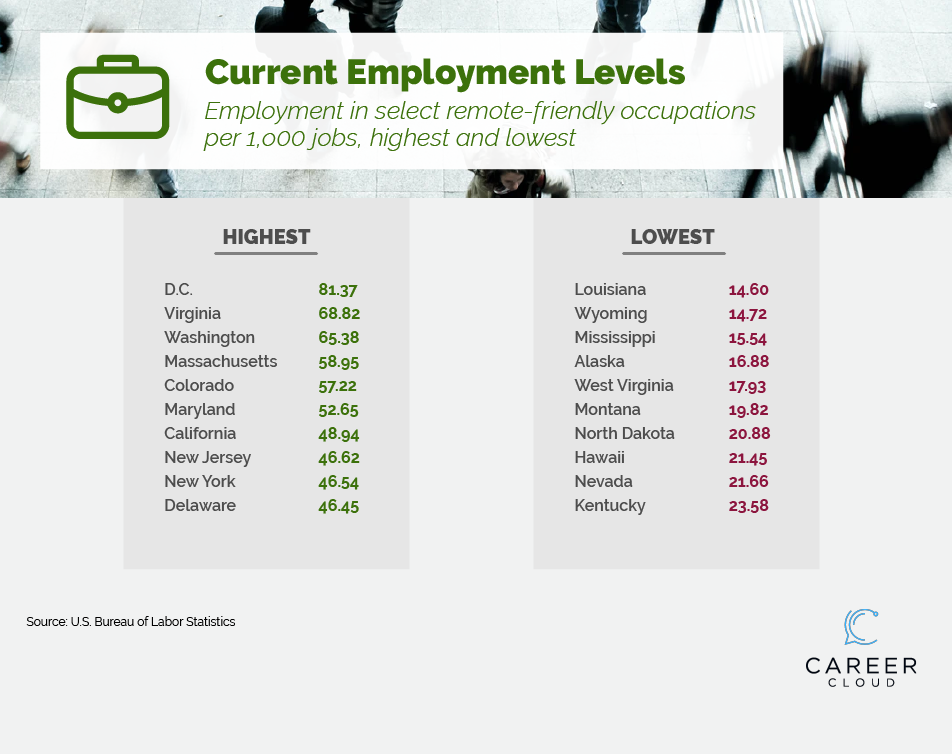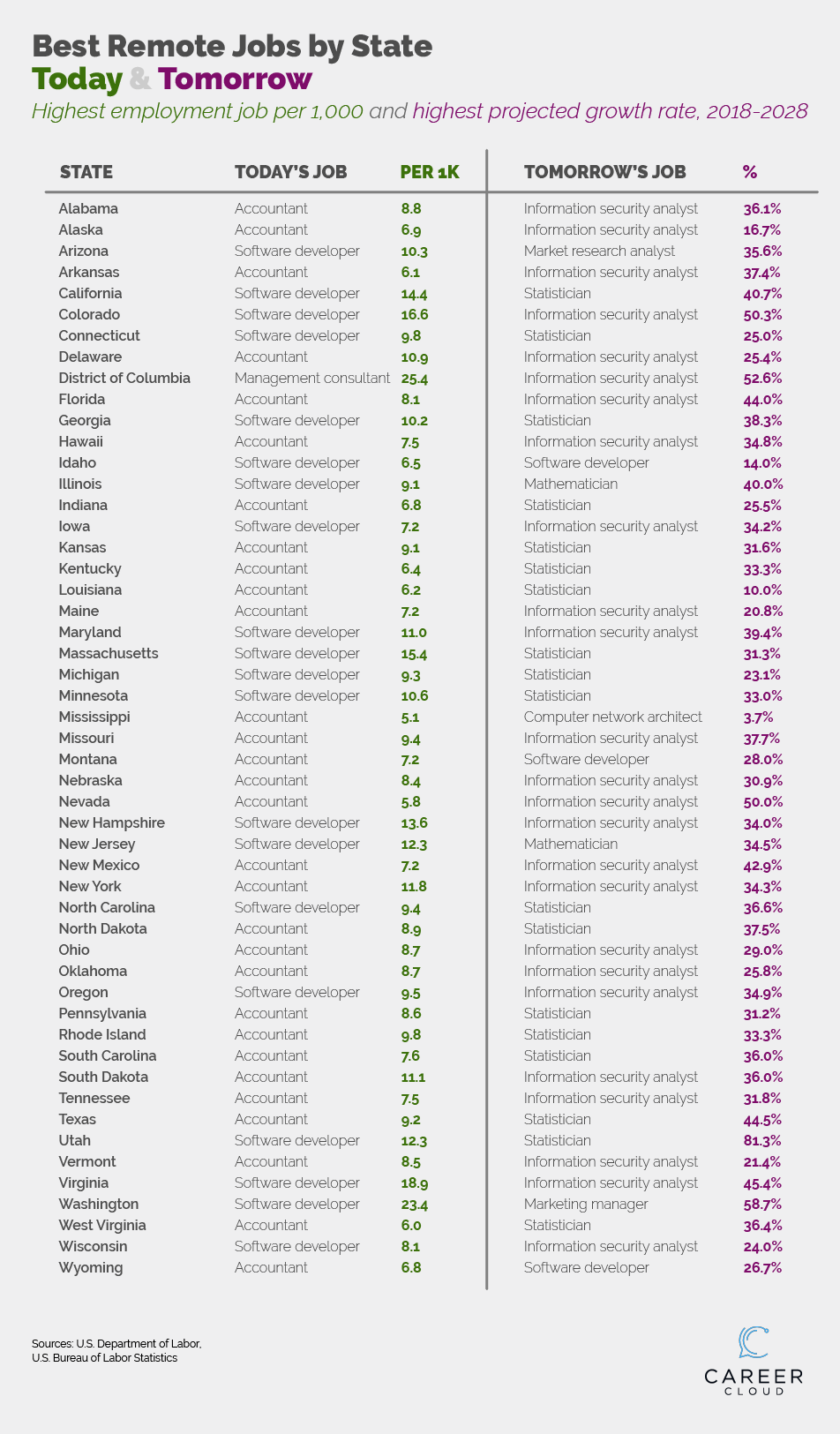
Long before the pandemic, the prevalence of remote-work arrangements was rising. In fact, the percentage of Americans who worked remotely before the pandemic had climbed by nearly 30% over the past decade.
As it has with everything else, the COVID-19 pandemic upended routines for many companies. Not every occupation can be done from home, but one analysis found that about one in five people could work from home. For companies in sectors like tech, that figure is even higher. In fact, remote-work capabilities are so high in tech that companies like Google and Facebook have extended pandemic-related work-from-home policies to summer 2021, while some have made these policies permanent. Spotify and Twitter, for example, are permitting employees to work from home permanently if they like.
We wanted to understand which states are best for remote workers, both today and tomorrow, so we analyzed employment data, job growth, and broadband access to find out which states have high rates of these jobs today and where growth will be the strongest over the next several years.
Jump to the bottom of the page for the full methodology.
Key Findings
- Utah is the best state for remote workers; Mississippi is the worst.
- Washington (4th overall) and Colorado (2nd overall) rank in the top 10 for all three categories considered in the study.
- Employment levels in remote-friendly jobs is highest in Washington, D.C., Utah has the highest projected growth rate, and Washington is No. 1 for broadband access.
Best States for Remote Job Seekers
To create our analysis of which states have the most promising outlook for remote job growth, we scored each state relative to the overall national rate across three metrics — employment per 1,000 jobs in a selection of remote-friendly occupations (read more about those jobs in the methodology section), projected growth rates in these jobs through 2028 and the percentage of people in each state with broadband at home. The states were assigned point values in each category relative to how much better (or worse) they are than the nation as a whole, and those points were added together to create the total score.
According to our analysis, Utah is the best state for remote job growth, while Mississippi is the worst. Colorado, D.C., Washington, and Virginia round out the top five, while Louisiana, Alaska, Maine, and Wyoming complete the bottom five.

Taking a look at regional comparisons, the West had by far the highest average score of the four major regions of the country, at 3.15, while the Midwest had the worst average total score, 2.84.
Utah took the top overall spot thanks to finishing No. 1 in job growth and No. 3 in broadband access despite a less-than-stellar placement in employment rates for high remote work jobs. But a couple of other states that landed in the top 10 overall were more consistently high-rated — Colorado (2nd overall) and Washington (4th overall) ranked in the top 10 for all three categories.

Breaking It Down
Taking a closer look at the data behind the rankings can help tell the picture of how attractive states are for remote workers (or companies looking to hire remote workers). Let’s break down the three categories.
CURRENT EMPLOYMENT LEVELS
The 14 remote work jobs we analyzed are relatively uncommon among all American jobs, according to data from the U.S. Bureau of Labor Statistics. Adjusting for population, the most common U.S. job is retail salesperson (30 per 1,000 jobs), followed by fast food/counter worker (26 per 1,000) and cashier (25 per 1,000). Of the remote jobs we studied, the most common nationally was accountant, which ranks No. 25 out of almost 800 individual job titles with a U.S. rate of 8.4 per 1,000.
Many high remote-work-capacity jobs are much more common in certain states than others, and the 14 jobs combined have a U.S. employment rate of about 36 per 1,000 jobs. Twenty-three states have higher rates, and the top area (Washington, D.C.) has by far the highest rate, more than double the U.S. rate. Given its high population density, that’s not much of a surprise, but a few other states also have remote job employment rates that near double the U.S. figure.

REMOTE JOB GROWTH
All 14 of the remote-friendly occupations we examined are projected to become more common over the next several years. In fact, according to information from the U.S. Department of Labor’s Projections Central database, two of the occupations (information security analyst and statistician) are expected to see job openings expand by more than 30% through 2028.
On average, the 14 jobs should enjoy growth of about 16%, which is four times higher than the 4% growth rate expected for all U.S. jobs. Utah, which experienced the highest population growth rate of any state over the past decade, also looks to be the epicenter of growth in remote-friendly jobs, with an average expansion rate of almost 42% for the selected jobs. No state is expected to see a drop in these jobs, but Mississippi and Louisiana are both expected to see very slow expansion of these occupations.

BROADBAND ACCESS
About 86.4% of Americans have access to broadband internet, according to U.S. Census Bureau data. Twenty-one states and the District of Columbia have broadband access rates higher than that.
For the lowest-ranking states, the split with the overall national rate is dramatic. The No. 1 state in this category, Washington, has a broadband coverage percentage that’s only about five percentage points higher than the overall U.S. rate, while Mississippi, the state with the lowest coverage rate, is almost 10 percentage points behind.

Best Remote Job by State
In every state, one of two remote-friendly jobs are most common of the 14 we studied — accountants and software developers. The sole exception is Washington, D.C., where management consultant positions are the most plentiful of the roles we studied.
There was slightly more variation when it comes to which remote-friendly jobs will expand the fastest over the next decade, but information security analysts and statisticians were the highest growth-potential jobs in 39 states and D.C. In exactly one state (Idaho) the best remote job of today is also the best remote job of tomorrow.

Setting Yourself Apart When Remote Job Hunting
Whether your ideal remote job is one of those we’ve discussed here or something else, there are a few tried-and-true tips for ensuring you’re the best candidate you can be. Here’s a look at the best ways to give yourself a leg up in your remote-work job search:
- Carefully curate your web presence: This means making sure that everything publicly available when searching for your name or checking out your internet profiles serves to reinforce your digital savviness, trustworthiness, credibility, and communication skills.
- Master the art of email communication: It’s easy to think of email as an informal communication tool, but many companies use emails to help screen candidates. They do this by looking for red flags, such as emails that are erratic, disorganized or off-topic (in a bad way). Make sure all emails you exchange with potential employers have a logical structure. Your main point should be made as near to the top as possible, and bullet points can help organize your thoughts. Candidates should strive for emails that are engaging but not overly formal, free of typos and just long enough to make the point.
- Ensure new-tech skills are on your resume: This means covering the technology directly related to your job but also apps and other tech-related to soft skills, even ones that may be relatively new. Think programs like Zoom, Slack, Google Drive, project management apps and more, as companies are looking to expand use of these programs as they grow their remote-work capacity.
- Practice Zoom interviews: Nailing a job interview today means more than wearing nice clothes and being personable. Get a friend, spouse, family member or colleague to help you improve your Zoom interview set up by doing a test call with you. Perfecting your setup may mean creating an area in your house just for video conferencing. Pay attention to the backdrop behind you, lighting, camera angles and volume. Test, adjust and test again before actual interviews. For more tips, read our guide on how to prepare for a video interview.
- Do your homework, and be prepared to get unconventional: Remote work is expanding rapidly, and depending on what you do, it’s likely that instead of a handful of candidates applying for jobs on a local basis, you’ll be up against hundreds from all around the country, or even the world. That means doing everything you can to set yourself apart. If you can locate the name of the hiring manager or person you’ll be interviewing with, look them up on social media and see if you have common friends or interests (if you’re already connected on social media, even better).
Methodology & Data Sources
To understand which states are the best for those seeking remote jobs both today and in the near future, we examined employment data, growth projections, and access to high-speed internet. In each of those three categories, states were compared to national rates or averages with points assigned relative to how much better (or worse) they are than that average, and totals in each category were summed to create the overall ranking. For example, Utah’s average growth rate for the selected jobs was about 42%, or 2.65 times higher than the overall U.S. rate of about 16%, so Utah received 2.65 points in that category, which represents about half of the state’s winning score.
Here’s a look at more details of the three data categories:
EMPLOYMENT
Using data from the U.S. Bureau of Labor Statistics, most recently updated in 2020, covering thousands of jobs in every state. Our analysis in this area focused on employment per 1,000 jobs for a group of common jobs that have the best chances of being done remotely, according to a U.S. News & World Report analysis. The 14 jobs are:
- Accountant
- Actuary
- Computer network architect
- Computer systems manager
- Computer systems analyst
- Database administrator
- Information security analyst
- Management analyst
- Market research analyst
- Marketing manager
- Mathematician
- Software developer
- Statistician
- Web developer
JOB GROWTH
Using the same 14 jobs, we analyzed long-term growth projections (2018-2028) for every job in each state using data from Projections Central, which is maintained by the U.S. Department of Labor. Not every job had available data in every state, but the lack of data in an area did not count against a state in the final total.
BROADBAND ACCESS
Being able to work remotely usually means having access to high-speed internet, so we also analyzed the percentage of residents in each state who have access to broadband internet. This data came from the U.S. Census Bureau’s most recent estimates, which cover 2019.
Source: Career Cloud












